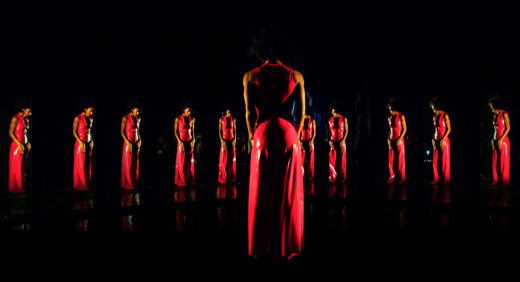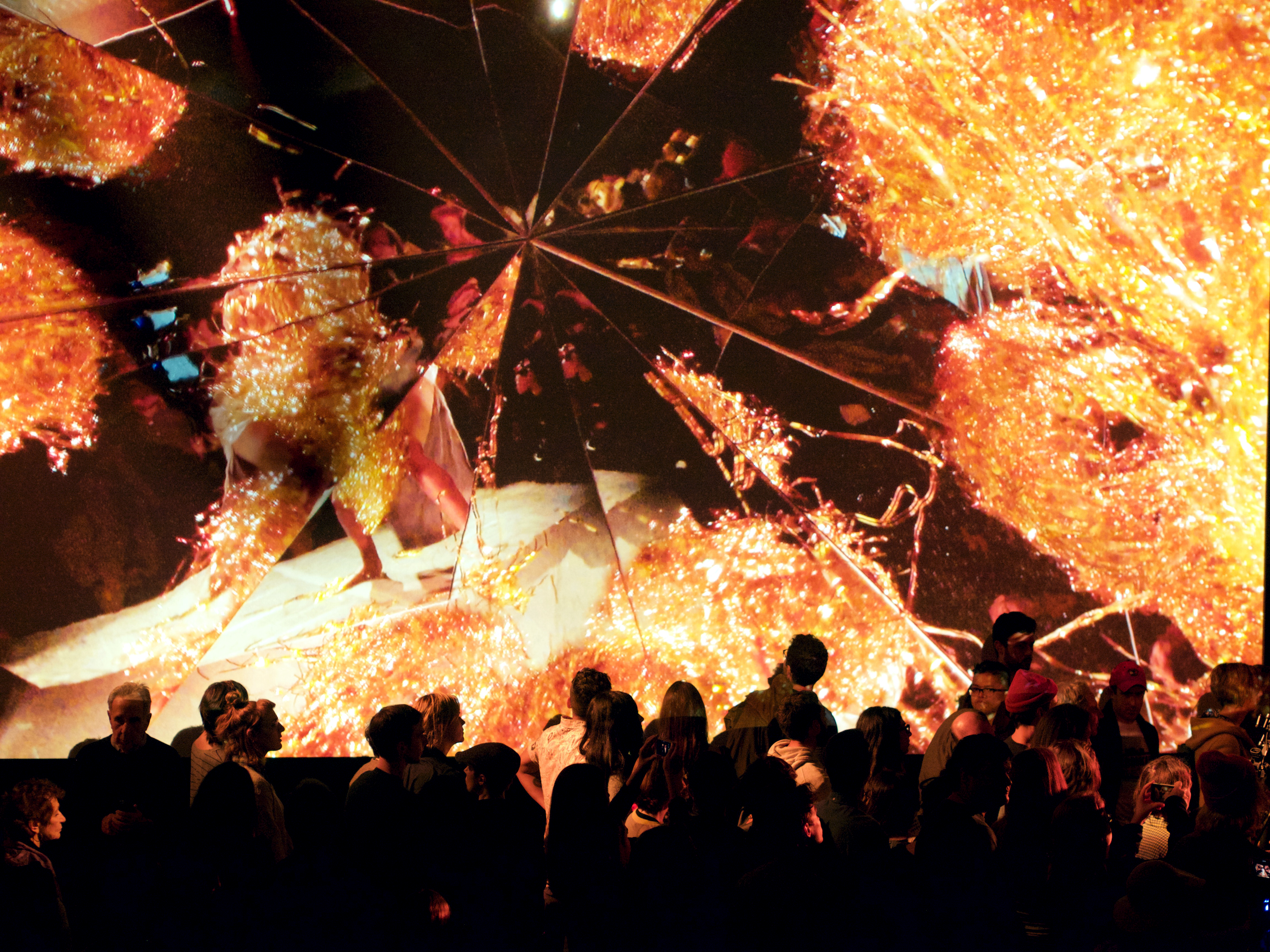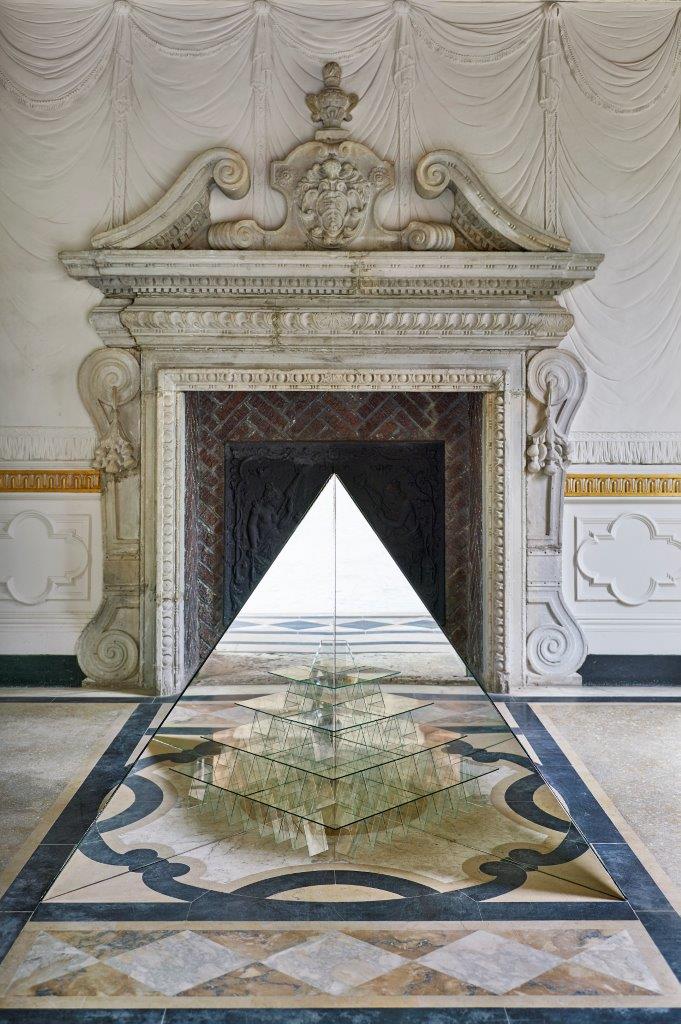MIRROR STAGES: Brookhart Jonquil in Conversation
Ariela Gittlen
 Scene from Yara Travieso's La Medea, with Brookhart Jonquil's set.
Scene from Yara Travieso's La Medea, with Brookhart Jonquil's set.
The nature of reality and its relation to our faculties of perception is a discourse central to Jonquil’s practice. It’s also a concern he shares with his close collaborator, Yara Travieso, the choreographer, director, and creator of La Medea, a hybrid dance-theater-film retelling of Euripides’ enduring story of an unruly woman, for which Jonquil designed the sets. The moving performance was staged in January as part of the Brooklyn-based Performance Space 122’s Coil Festival, then shown as a film with a live score in New York City and Miami.
Although Jonquil describes the project as intensely collaborative from the get-go, his most visible contribution consists of two stages, one with swiveling mirror panels, the other a concave plane with triangular mirrors radiating from its center (imagine looking straight into the faceted face of a large diamond). These sets reflect the movements of the dancers, the upturned faces of the audience, and the peregrinations of the camera crew who film each performance. La Medea is presented as a mash-up of a telenovela and daytime talk show, but stripped of the careful artifice of those formats. “The cameras are always in the shot and the audience is always in the shot, revealed through the mirrors,” Jonquil explains. “There is no ‘behind the scenes’ because everything is always visible.”
Jonquil’s approach is distinctly minimal, inspired more by Donald Judd than TV talk shows, but it is complimented by Travieso’s maximalist aesthetic. “Yara incorporates everything all at once—every genre of music, cinematic trope, and dance style,” he tells me. “But she’s really interested in the void, in so completely overwhelming the senses that it all dissolves into nothing.” Unlike the majority of his sculptures, which use light and reflection to complete geometric forms, Jonquil’s sets for La Medea fracture and and dislocate the performers, the same way that looking at a human body through a kaleidoscope causes it to break apart rather than coalesce. These visuals seem to echo the action of the play, the story of a woman and her family fragmented by betrayal, exile, and murder. “My world is the reality beyond what we live in, but Yara’s is all about the reality we live in. She’s very much concerned about social, political, and human interactions,” Jonquil adds. “And reality gets messy, so when you look at it through a very rational framework, it completely breaks it apart.”
The artist’s usual primary materials are architectural: steel, glass, cement, and fluorescent tubes. His explorations of perception are colored by a fascination with failed modernist utopias, whether unrealized visions like Le Corbusier’s Plan Voisin or practical failures like Oscar Niemeyer’s Brasilia. Quixotic plans to build an ideal space in order to shape a perfect society have long fascinated him. “I’m interested in the idea that perfection is something that can’t exist in the world, but that it is something that we can conceive of,” Jonquil explains. “I try to make sculptures that have as little as possible to do with physical materiality.” Instead Jonquil relies on reflections, light, and space to complete his works, which, out of necessity, are anchored to the physical world but extend to a dimension beyond it. This imagined space is the realm of perception, the only place where ideal forms and perfect societies can exist.

Scene from Yara Travieso’s La Medea, with Brookhart Jonquil’s set.
For Jonquil, these notions of intangibility are the truth of our physical world, which at the subatomic level is essentially transitory. “Everything is constantly changing, our cells are always contracting and shifting, and most physical material is just emptiness,” he tells me. However, the ideal forms, which can’t exist in this state of flux, live in our minds as pure mathematical abstractions. These are the forms he attempts to evoke within his sculptures: “I see the ideal forms as templates for reality. If I put two mirrors at a certain angle with a fluorescent light passing between them, it will create a triangle, but mess those angles up just a little bit [and] it makes a wonky shape that isn’t anything. There’s no exact 120 degrees in the physical world, but there is the experience of seeing a triangle. Our experience of that object can have something that at least brushes against that sort of perfection Plato talks about.”

Brookhart Jonquil, Glass House/Invisible Sun, 2016, commissioned by Vizcaya Museum and Gardens. Photo: David Almeida, courtesy Vizcaya Museum and Gardens.
Brookhart Jonquil’s work will be on view in “Lost Spaces and Stories of Vizcaya” at the Vizcaya Museum & Gardens in Miami FL, through October 2017.
Ariela Gittlen is a writer and designer living in Brooklyn, New York.










